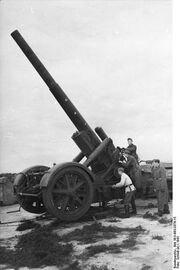The 210 mm Mörser 18 was a German heavy howitzer used in the Second World War. Its predecessors date back to World War I, with minor improvements that allowed it to be towed by truck. Perfect against fortifications, it was best used as fixed or siege artillery, providing fire support at a very long range. Its high-angled 120 kg shells can easily blast any building or light troop concentrations, even if unidentified by recon. However the "Mӧrser" is not very precise at long range and is handicapped in being extremely slow.
The Mörser 18 was an enormous weapon that was transported in two pieces, as was common for such large weapons. For travel the barrel was slid on to a separate trailer. The carriage carried an integral firing platform that was lowered to the ground when emplacing the howitzer. The wheels were then cranked up off the ground and it was now ready for firing. A rear castor-wheel jack was used to raise the rear spade off the ground if the gun needed to be traversed more than the 16° allowed by the mount proper.
The Mörser 18 entered production at a low rate in shortly before the war began. The Germans canceled production in 1942 in lieu of its smaller brother, the 17 cm Kanone 18 in Mörserlafette, which could fire almost twice as far, but resumed production in 1943.
History[]

The Mörser 18 was designed to replace the obsolescent World War I-era 21 cm Mörser 16. While the gun design itself was nothing innovative, the same cannot be said for the carriage. It was one of the first weapons, if not the first in quantity production, that used the interesting dual-recoil system. The barrel recoiled normally in its cradle, but, in addition, the whole top carriage, which carried the barrel and its cradle, recoiled across the main part of the carriage. This system damped out the recoil forces and made for a very steady firing platform. This carriage was also used for the 17cm Kanone 18 in Mörserlafette and the 15cm Schnelladekanone C/28 in Mörserlafette.
The Mörser 18 was an enormous weapon that was transported in two pieces, as was common for such large weapons. For travel the barrel was slid on to a separate trailer. The carriage carried an integral firing platform that was lowered to the ground when emplacing the howitzer. The wheels were then cranked up off the ground and it was now ready for firing. A rear castor-wheel jack was used to raise the rear spade off the ground if the gun needed to be traversed more than the 16° allowed by the mount proper.
The Mörser 18 entered production at a low rate in shortly before the war began. The Germans canceled production in 1942 in lieu of its smaller brother, the 17 cm Kanone 18 in Mörserlafette, which could fire almost twice as far, but resumed production in 1943.
Strategies and Tactics[]
- The Mörser, when by itself, is nearly useless against enemy structures and soft targets. Its accuracy is horrendous, but when five or more Mörser artillery pieces are firing in the vicinity of your enemy's base, the outcome will satisfy you. Unfortunately, the Mörser comes at a high price - $60, as well as the lengthy time it takes to research and deploy them.
- The Mörser is an amazing tool of destruction, although it is quite fragile. Enemy aircraft can take these out with ease, so air cover is a necessity. A few tanks should also be present around the column of artillery to protect against ground attack. These are high-value targets, the cost of replacing these will be a painful thorn in your side.
Pros & Cons[]
This section is a stub, so be patient and expand it.
Weapons[]
| Weapon | ||||||||||
|---|---|---|---|---|---|---|---|---|---|---|
Large cal. HE Shell |
31 | 31 | 31 | 6 | 3 | 2 | 1 | 0 | 2400 m |
Gallery[]
Trivia[]
- While the in-game information states that the unit is the Mörser 16, the image and the in-game model shows that of the Mörser 18.
- In reality the Morser is pre-World War 2 as it dates back to WW1, ironicly the war make in the game for it is 1945.
See also[]
| ||||||||||||||||||||||||||

